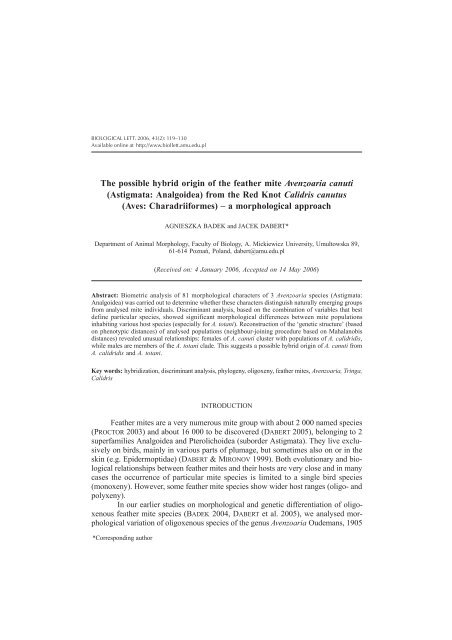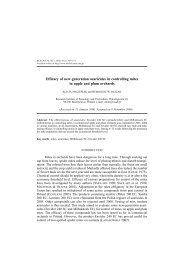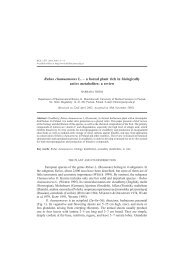The possible hybrid origin of the feather mite Avenzoaria canuti ...
The possible hybrid origin of the feather mite Avenzoaria canuti ...
The possible hybrid origin of the feather mite Avenzoaria canuti ...
You also want an ePaper? Increase the reach of your titles
YUMPU automatically turns print PDFs into web optimized ePapers that Google loves.
THE POSSIBLE HYBRID THE FEATHER MITE AVENZOARIA CANUTI<br />
BIOLOGICAL LETT. 2006, 43(2): 119–130<br />
Available online at http://www.biollett.amu.edu.pl<br />
<strong>The</strong> <strong>possible</strong> <strong>hybrid</strong> <strong>origin</strong> <strong>of</strong> <strong>the</strong> fea<strong>the</strong>r <strong>mite</strong> <strong>Avenzoaria</strong> <strong>canuti</strong><br />
(Astigmata: Analgoidea) from <strong>the</strong> Red Knot Calidris canutus<br />
(Aves: Charadriiformes) – a morphological approach<br />
AGNIESZKA BADEK and JACEK DABERT*<br />
Department <strong>of</strong> Animal Morphology, Faculty <strong>of</strong> Biology, A. Mickiewicz University, Umultowska 89,<br />
61-614 Poznañ, Poland, dabert@amu.edu.pl<br />
(Received on: 4 January 2006, Accepted on 14 May 2006)<br />
119<br />
Abstract: Biometric analysis <strong>of</strong> 81 morphological characters <strong>of</strong> 3 <strong>Avenzoaria</strong> species (Astigmata:<br />
Analgoidea) was carried out to determine whe<strong>the</strong>r <strong>the</strong>se characters distinguish naturally emerging groups<br />
from analysed <strong>mite</strong> individuals. Discriminant analysis, based on <strong>the</strong> combination <strong>of</strong> variables that best<br />
define particular species, showed significant morphological differences between <strong>mite</strong> populations<br />
inhabiting various host species (especially for A. totani). Reconstruction <strong>of</strong> <strong>the</strong> ‘genetic structure’ (based<br />
on phenotypic distances) <strong>of</strong> analysed populations (neighbour-joining procedure based on Mahalanobis<br />
distances) revealed unusual relationships: females <strong>of</strong> A. <strong>canuti</strong> cluster with populations <strong>of</strong> A. calidridis,<br />
while males are members <strong>of</strong> <strong>the</strong> A. totani clade. This suggests a <strong>possible</strong> <strong>hybrid</strong> <strong>origin</strong> <strong>of</strong> A. <strong>canuti</strong> from<br />
A. calidridis and A. totani.<br />
Key words: <strong>hybrid</strong>ization, discriminant analysis, phylogeny, oligoxeny, fea<strong>the</strong>r <strong>mite</strong>s, <strong>Avenzoaria</strong>, Tringa,<br />
Calidris<br />
INTRODUCTION<br />
Fea<strong>the</strong>r <strong>mite</strong>s are a very numerous <strong>mite</strong> group with about 2 000 named species<br />
(PROCTOR 2003) and about 16 000 to be discovered (DABERT 2005), belonging to 2<br />
superfamilies Analgoidea and Pterolichoidea (suborder Astigmata). <strong>The</strong>y live exclusively<br />
on birds, mainly in various parts <strong>of</strong> plumage, but sometimes also on or in <strong>the</strong><br />
skin (e.g. Epidermoptidae) (DABERT & MIRONOV 1999). Both evolutionary and biological<br />
relationships between fea<strong>the</strong>r <strong>mite</strong>s and <strong>the</strong>ir hosts are very close and in many<br />
cases <strong>the</strong> occurrence <strong>of</strong> particular <strong>mite</strong> species is li<strong>mite</strong>d to a single bird species<br />
(monoxeny). However, some fea<strong>the</strong>r <strong>mite</strong> species show wider host ranges (oligo- and<br />
polyxeny).<br />
In our earlier studies on morphological and genetic differentiation <strong>of</strong> oligoxenous<br />
fea<strong>the</strong>r <strong>mite</strong> species (BADEK 2004, DABERT et al. 2005), we analysed morphological<br />
variation <strong>of</strong> oligoxenous species <strong>of</strong> <strong>the</strong> genus <strong>Avenzoaria</strong> Oudemans, 1905<br />
*Corresponding author
120 Agnieszka Badek and Jacek Dabert<br />
Fig. 1. Analysed species <strong>of</strong> <strong>the</strong> genus <strong>Avenzoaria</strong>. A – A. totani, male, dorsal view; B – A. totani, female,<br />
dorsal view; C – A. <strong>canuti</strong>, male; D – A. <strong>canuti</strong>, female; E – A. calidridis: male, dorsal view; F –<br />
A. calidridis, female, dorsal view
THE POSSIBLE HYBRID THE FEATHER MITE AVENZOARIA CANUTI<br />
121<br />
(Avenzoariidae, Avenzoariinae). Mites <strong>of</strong> this genus occur on <strong>the</strong> vane surface <strong>of</strong> wing<br />
contour fea<strong>the</strong>rs in waders <strong>of</strong> suborders Charadrii and Scolopaci (Charadriiformes).<br />
We selected 2 species for <strong>the</strong> analysis: A. totani (Canestrini, 1878) (Fig. 1 A–B) and<br />
A. calidridis (Oudemans, 1904) (Fig. 1 E–F), which are commensals <strong>of</strong> tattlers (Tringa<br />
L., 1758) and sandpipers (Calidris Merrem, 1804), respectively. <strong>The</strong>se 2 species are<br />
very similar according to discrete morphological characters but relatively distant<br />
genetically (DABERT et al. 2001). Analysis <strong>of</strong> <strong>the</strong> variability <strong>of</strong> both quantitative and<br />
discrete morphological characters was conducted to determine whe<strong>the</strong>r populations<br />
<strong>of</strong> A. calidridis and A. totani inhabiting various host species differ significantly each<br />
o<strong>the</strong>r and, if so, what is <strong>the</strong> taxonomic status <strong>of</strong> <strong>the</strong> <strong>possible</strong> differences. We had<br />
previously found that <strong>the</strong> <strong>Avenzoaria</strong> population occurring on <strong>the</strong> Red Knot Calidris<br />
canutus (L., 1766) that was formerly recognized as A. calidridis shows, apart from<br />
<strong>the</strong>ir own characteristic features also typical characters <strong>of</strong> both A. calidridis and A.<br />
totani. We gave this population a species rank and described it as a new species: A.<br />
<strong>canuti</strong> (Fig. 1 C–D) (BADEK & DABERT 2005). In <strong>the</strong> present paper we show <strong>the</strong><br />
results <strong>of</strong> <strong>the</strong> morphological analysis <strong>of</strong> this species compared with ones made for<br />
particular populations <strong>of</strong> A. calidridis and A. totani sampled from various host species.<br />
Our main aim here was to reconstruct <strong>the</strong> phylogenetic relationships among <strong>the</strong>se<br />
<strong>mite</strong> populations and to hypo<strong>the</strong>size <strong>the</strong> <strong>origin</strong> <strong>of</strong> A. <strong>canuti</strong>.<br />
MATERIALS AND METHODS<br />
<strong>The</strong> material used in <strong>the</strong> present study <strong>origin</strong>ates from <strong>the</strong> acarological collection<br />
<strong>of</strong> <strong>the</strong> Department <strong>of</strong> Animal Morphology, Adam Mickiewicz University, Poznañ,<br />
and was sampled in Poland and South Africa in 1983-1991 (Table 1). <strong>Avenzoaria</strong><br />
Table 1. Basic information on <strong>the</strong> analysed <strong>mite</strong> samples<br />
No. <strong>Avenzoaria</strong> Host species Location Date No. <strong>of</strong> specimens<br />
species<br />
measured<br />
males females<br />
1 A. totani Tringa glareola Turawskie Lake, Poland Aug 1984 17 23<br />
2 A. totani T. glareola S³oñsk near Kostrzyn, Poland Jul 1987 22 20<br />
3 A. totani T. glareola S³oñsk near Kostrzyn, Poland Jul 1988 12 17<br />
4 A. totani T. stagnatilis S³oñsk near Kostrzyn, Poland Jul 1987 6 8<br />
5 A. totani T. totanus Zagórów, Poland<br />
May 1988 11 18<br />
S³oñsk near Kostrzyn, Poland Aug 1988<br />
6 A. <strong>canuti</strong> Calidris canutus Vistula Mouth, Poland<br />
Aug 1985 14 65<br />
Velddrif, South Africa<br />
Nov 1991<br />
7 A. calidridis C. alpina Vistula Mouth, Poland<br />
Aug 1985 2 13<br />
Sowiniec near Poznañ, Poland Sep 1990<br />
8 A. calidridis C. minuta Sowiniec near Poznañ, Poland Sep 1985 3 39<br />
Vistula Mouth, Poland<br />
Sep 1990<br />
S³oñsk near Kostrzyn, Poland Jul 1987<br />
Velddrif, South Africa<br />
Nov 1991<br />
9 A. calidridis C. temminckii S³oñsk near Kostrzyn, Poland Jul 1987 14 28<br />
10 A. calidridis C. ferruginea S³oñsk near Kostrzyn, Poland Aug 1988 8 40<br />
Vistula Mouth, Poland<br />
Aug 1990<br />
11 A. calidridis C. alba Vistula Mouth, Poland<br />
Aug 1990 15 19<br />
Górki Wschodnie near Gdañsk,<br />
Poland<br />
Oct 1990
122 Agnieszka Badek and Jacek Dabert<br />
Fig. 2. Ornamentation patterns <strong>of</strong> hysteronotal shield in particular <strong>Avenzoaria</strong> taxa. 1 = A. totani from<br />
Tringa glareola population 1; 2 = A. totani from T. glareola population 2; 3 = A. totani from T. glareola<br />
population 3; 4 = A. totani from T. stagnatilis; 5 = A. totani from T. totanus; 6 = A. <strong>canuti</strong> from Calidris<br />
canutus; 7 = A. calidridis from C. alpina; 8 = A. calidridis from C. minuta; 9 = A. calidridis from C.<br />
temminckii; 10 = A. calidridis from C. ferruginea; 11 = A. calidridis from C. alba. Numbers <strong>of</strong> T. glareola<br />
populations refer to locations given in Table 1.<br />
<strong>mite</strong>s were mounted on slides in Faure medium (EVANS 1992) and examined using<br />
a light microscope Olympus BH-2 with Nomarsky phase contrast. We measured 154<br />
individuals <strong>of</strong> A. totani, collected from 3 Tringa species: T. totanus (L., 1758),<br />
T. glareola L., 1758, and T. stagnatilis (Bechstein, 1803); 181 <strong>of</strong> A. calidridis from<br />
5 Calidris species: C. alba (Pallas, 1764), C. ferruginea (Pontoppidan, 1763), C. minuta<br />
(Leisler, 1812), C. alpina (L., 1758), and C. temminckii (Leisler, 1812); and 79 <strong>of</strong><br />
A. <strong>canuti</strong> from C. canutus. Biometric analyses <strong>of</strong> variation <strong>of</strong> 77 morphological quantitative<br />
characters and 4 discrete ones (see: Appendix) were conducted for adult stages<br />
<strong>of</strong> above-mentioned <strong>mite</strong>s. <strong>The</strong> setal nomenclature follows GAUD & ATYEO (1996).
THE POSSIBLE HYBRID THE FEATHER MITE AVENZOARIA CANUTI<br />
123<br />
Fig. 3. Location <strong>of</strong> genital acetabula in males. A = aedeagus base located posteriorly to both pairs <strong>of</strong><br />
genital acetabula; B = aedeagus base located at <strong>the</strong> level <strong>of</strong> posterior pair <strong>of</strong> genital acetabula; C = aedeagus<br />
base located between anterior and posterior pair <strong>of</strong> genital acetabula. Numbers refer to populations<br />
mentioned in Fig. 2.<br />
Fig. 4. Shape <strong>of</strong> <strong>the</strong> interior tooth <strong>of</strong> <strong>the</strong> postlobar membrane. A = rectangular with a concave terminal<br />
margin; B = semicircular. Numbers refer to populations mentioned in Fig. 2.<br />
Discriminant function analysis was used to detect if particular quantitative characters<br />
make it <strong>possible</strong> to distinguish groups among <strong>the</strong> analysed <strong>Avenzoaria</strong> individuals,<br />
and <strong>the</strong>n <strong>the</strong> canonical variables were computed. <strong>The</strong> main aim <strong>of</strong> <strong>the</strong> study<br />
was to discover, basing on quantitative morphological characters, <strong>the</strong> <strong>possible</strong> structure<br />
<strong>of</strong> genetic distances <strong>of</strong> analysed populations. <strong>The</strong>re are several evidences that<br />
<strong>the</strong>re is significant correlation between phylogenetic and morphological distances (e.g.<br />
MARROIG & CHEVERUD 2001, DIAS et al. 2004). <strong>The</strong> phylogenetic tree was recon-
124 Agnieszka Badek and Jacek Dabert<br />
Fig. 5. Results <strong>of</strong> <strong>the</strong> discriminant analysis for <strong>the</strong> populations <strong>of</strong> females (A, B) and males (C, D). A<br />
and C = A. totani from various hosts (1–5) and A. <strong>canuti</strong> from C. canutus (6); B and D = A. <strong>canuti</strong> from<br />
C. canutus (6) and A. calidridis from various hosts (7–11). Numbers refer to populations mentioned in<br />
Fig. 2. Z1 and Z2 = values <strong>of</strong> 1st and 2nd canonical discriminant functions.<br />
structed using <strong>the</strong> neighbour-joining (NJ) procedure as implemented in PAUP 4*<br />
s<strong>of</strong>tware (SWOFFORD 2002). We used a Mahalanobis distance (D 2 ) matrix as <strong>the</strong> source<br />
data for reconstructing <strong>the</strong> phenogram. <strong>The</strong>se are distances between 2 points (centroids)<br />
in <strong>the</strong> multidimensional space defined by several correlated independent variables<br />
and are commonly used to reveal a genetic structure from morphometric data<br />
(e.g. MARROIG & CHEVERUD 2001, ACKERMANN & CHEVERUD 2002, HARVATI et<br />
al. 2004, DIAS et al. 2004).<br />
All <strong>the</strong> statistical analyses were carried out by means <strong>of</strong> Statistica 6.0 s<strong>of</strong>tware.<br />
<strong>The</strong> graphic visualization <strong>of</strong> <strong>the</strong> phylogenetic trees was made by TreeView 1.6.6<br />
s<strong>of</strong>tware (PAGE 2001).
THE POSSIBLE HYBRID THE FEATHER MITE AVENZOARIA CANUTI<br />
RESULTS<br />
125<br />
Fig. 6. Summarized results <strong>of</strong> discriminant analysis for <strong>the</strong> populations <strong>of</strong> <strong>Avenzoaria</strong> totani, A. <strong>canuti</strong><br />
and A. calidridis. A = females; B = males. Z1 and Z2 = values <strong>of</strong> 1st and 2nd canonical discriminant<br />
functions.<br />
Discriminant function analysis<br />
From 4 discrete characters, all turned out to be informative and useful for recognizing<br />
differences between <strong>Avenzoaria</strong> populations from various hosts. Examples<br />
<strong>of</strong> <strong>the</strong> results are shown in Figures 2–4.<br />
<strong>The</strong> discriminant function analysis was carried out on 77 quantitative characters<br />
separately for males and females (47 and 34 characters, respectively). It enabled<br />
selection <strong>of</strong> 17 male characters and 9 female ones that differentiated <strong>the</strong> best between<br />
all <strong>the</strong> populations <strong>of</strong> particular host species (P < 0.05). Scatter plots (Figs. 5, 6) and<br />
<strong>the</strong> Appendix summarize <strong>the</strong> results.<br />
On <strong>the</strong> basis <strong>of</strong> ei<strong>the</strong>r males or females, populations <strong>of</strong> A. totani are not homogeneous<br />
(Fig. 5A, C). Populations from Tringa glareola (1–3) cluster toge<strong>the</strong>r and<br />
are separated from remaining A. totani populations living on T. stagnatilis (4) and T.<br />
totanus (5). In populations <strong>of</strong> females <strong>of</strong> A. calidridis, we can observe a tendency to<br />
clinal variability along <strong>the</strong> gradient temminckii (9) – [alpina (7), ferruginea (10),<br />
minuta (8)] – alba (11), with <strong>the</strong> 2 extremes <strong>of</strong> this cline, temminckii (9) and alba<br />
(11), differing significantly (Fig. 5B). Particular populations <strong>of</strong> males <strong>of</strong> A. calidridis<br />
cluster separately and somewhat differently from females but because <strong>of</strong> <strong>the</strong><br />
small number <strong>of</strong> individuals studied (especially from Calidris minuta and C. alpina),<br />
<strong>the</strong> results are less credible than in <strong>the</strong> case <strong>of</strong> females (Fig. 5D).<br />
In all cases <strong>the</strong> discriminant function analysis separated well <strong>the</strong> individuals <strong>of</strong><br />
A. <strong>canuti</strong> (from Calidris canutus) not only from A. totani but also from A. calidridis,<br />
with which it has been considered conspecific for a long time. However, A. <strong>canuti</strong><br />
can be similar to A. totani in some characters (e.g. in distance between setae h1-ps1<br />
or between d2-d2, location <strong>of</strong> genital acetabula, Fig. 3) and in o<strong>the</strong>rs to A. calidridis<br />
(e.g. in distance between setae e2-h1 or between d2-d2, ornamentation <strong>of</strong> hysterono-
126 Agnieszka Badek and Jacek Dabert<br />
Fig. 7. Unrooted neighbour-joining trees for males and females. Host names are shown in paren<strong>the</strong>ses.<br />
Numbers in T. glareola designate <strong>the</strong> population locations given in Table 1.<br />
tal shield, Fig. 2). It shows also intermediate proportions <strong>of</strong> 2 character states between<br />
A. totani and A. calidridis (e.g. shape <strong>of</strong> interior tooth <strong>of</strong> <strong>the</strong> postlobar membrane,<br />
Fig. 4).<br />
A summary <strong>of</strong> results <strong>of</strong> <strong>the</strong> discriminant analysis for all 11 populations studied<br />
is presented in Figure 6. It shows very clearly that for both males and females<br />
we have to do with 3 morphologically distinct clusters <strong>of</strong> individuals that most probably<br />
have a species rank.<br />
Phylogenetic analysis<br />
<strong>The</strong> results <strong>of</strong> <strong>the</strong> phylogenetic analysis are very surprising. <strong>The</strong> reconstructed<br />
tree <strong>of</strong> males differs from female one for some clusters (Fig. 7).<br />
In both trees, A. totani and A. calidridis populations are located in separate<br />
clades, which supports <strong>the</strong>ir placement in different taxa (species?). <strong>The</strong>re is a distinct<br />
tendency in <strong>the</strong> cluster totani to differentiation <strong>of</strong> 2 monophyletic groups: (1)<br />
<strong>origin</strong>ating from Tringa glareola; and (2) from T. totanus and T. stagnatilis. <strong>The</strong><br />
interpretation <strong>of</strong> <strong>the</strong> calidridis cluster is more uncertain because <strong>the</strong> pattern is based<br />
on a very small number <strong>of</strong> males for Calidris alpina and C. minuta. Yet <strong>the</strong> reciprocal<br />
relationships <strong>of</strong> <strong>the</strong> remaining taxa – C. alba, C. ferruginea, and C. temminckii<br />
– is <strong>the</strong> same in both male and female trees.
THE POSSIBLE HYBRID THE FEATHER MITE AVENZOARIA CANUTI<br />
127<br />
However, <strong>the</strong> most important result <strong>of</strong> <strong>the</strong> analysis is <strong>the</strong> different clustering<br />
<strong>of</strong> A. <strong>canuti</strong> depending on <strong>the</strong> sex examined. This species joins <strong>the</strong> cluster <strong>of</strong> A. totani<br />
populations in <strong>the</strong> cladogram reconstructed for males. In <strong>the</strong> female tree it falls among<br />
<strong>the</strong> A. calidridis populations. It is worthy <strong>of</strong> mention that in both cases A. <strong>canuti</strong> does<br />
not build a sister clade for respective species but is deeply nested in each <strong>of</strong> <strong>the</strong><br />
clusters.<br />
DISCUSSION<br />
<strong>The</strong> present analyses have confirmed our previous presumptions (DABERT 1991,<br />
BADEK & DABERT 2005) that A. <strong>canuti</strong> from <strong>the</strong> Red Knot resembles in some respects<br />
<strong>the</strong> species A. calidridis (e.g. rounded lacunae on <strong>the</strong> hysteronotal shield), and<br />
in o<strong>the</strong>r respects A. totani (e.g. anterior location <strong>of</strong> genital acetabula, setae h1 not<br />
reaching <strong>the</strong> margins <strong>of</strong> interlobar membranes). Moreover, A. <strong>canuti</strong> has also its own<br />
characteristic features: females are bigger and have posterior legs extending much<br />
more posteriorly than populations <strong>of</strong> <strong>the</strong> o<strong>the</strong>r 2 species.<br />
It is difficult to state on <strong>the</strong> basis <strong>of</strong> our present knowledge exactly how A.<br />
<strong>canuti</strong> <strong>origin</strong>ated. We consider <strong>the</strong> most likely hypo<strong>the</strong>sis to be that A. <strong>canuti</strong> is a<br />
<strong>hybrid</strong> between A. totani and A. calidridis. <strong>The</strong> main premise for such a statement is<br />
provided by <strong>the</strong> unusual results <strong>of</strong> <strong>the</strong> phylogenetic analysis, where 2 different trees<br />
for males and females were obtained. In <strong>the</strong> male tree A. <strong>canuti</strong> is in <strong>the</strong> middle <strong>of</strong><br />
<strong>the</strong> A. totani cluster, while in <strong>the</strong> female tree A. <strong>canuti</strong> is a member <strong>of</strong> <strong>the</strong> A. calidridis<br />
clade. We hypo<strong>the</strong>size that A. <strong>canuti</strong> represents a <strong>hybrid</strong> <strong>of</strong> closely related species,<br />
which by inhabiting a new host species achieved reproductive isolation from<br />
both parental species. <strong>The</strong> behaviour <strong>of</strong> <strong>the</strong> host Calidris canutus may have preadapted<br />
it to <strong>the</strong> role <strong>of</strong> a living ‘<strong>hybrid</strong>ization zone’. This sandpiper groups during<br />
feeding into mixed flocks with o<strong>the</strong>r waders: calidrine sandpipers <strong>of</strong> <strong>the</strong> genus Calidris<br />
(hosting A. calidridis), <strong>the</strong> Ruff Philomachus pugnax (with A. philomachi), and<br />
tringine tattlers <strong>of</strong> <strong>the</strong> genus Tringa (with A. totani 1 ). By contrast, in breeding biotopes,<br />
<strong>the</strong> Red Knot coexists with <strong>the</strong> Ruddy Turnstone Arenaria interpres (with<br />
A. arenarii) (DABERT 1991). To test <strong>the</strong> <strong>hybrid</strong>ization hypo<strong>the</strong>sis on <strong>the</strong> <strong>origin</strong> <strong>of</strong><br />
A. <strong>canuti</strong>, molecular sequencing data are necessary; this analysis is currently being<br />
carried out in our lab.<br />
<strong>The</strong> morphometric, discriminant, and phylogenetic analyses have revealed also<br />
some consistent differences between A. totani populations inhabiting Tringa glareola<br />
(Figs. 3, 5A, C) and o<strong>the</strong>r populations inhabiting both remaining host species. As<br />
in <strong>the</strong> case <strong>of</strong> A. <strong>canuti</strong>, only DNA sequencing could help to verify <strong>the</strong> relationships<br />
between <strong>the</strong>se populations.<br />
1 O<strong>the</strong>r species <strong>of</strong> tringine tattlers host <strong>the</strong> fea<strong>the</strong>r <strong>mite</strong> species <strong>Avenzoaria</strong> tringae, A. australis, and<br />
A. gambettae. However <strong>the</strong>se particular waders do not coexist with Calidris canutus.
128 Agnieszka Badek and Jacek Dabert<br />
REFERENCES<br />
ACKERMANN R. R., CHEVERUD J. M. 2002. Discerning evolutionary processes in patterns <strong>of</strong> Tamarin<br />
(genus Saguinus) crani<strong>of</strong>acial variation. Am. J. Phys. Antropol. 117: 260–271.<br />
BADEK A. 2004. Taxonomic status <strong>of</strong> oligoxenic fea<strong>the</strong>r <strong>mite</strong> species <strong>Avenzoaria</strong> totani Canestrini,<br />
1878 and A. calidridis Oudemans, 1905 (Astigmata, Analgoidea, Avenzoariidae). Unpubl. MSc<br />
<strong>the</strong>sis, Faculty <strong>of</strong> Biology, A. Mickiewicz University, Poznañ (in Polish).<br />
BADEK A., DABERT J. 2005. A new species <strong>of</strong> <strong>the</strong> genus <strong>Avenzoaria</strong> Oudemans, 1905 (Acari:<br />
Avenzoariidae) from <strong>the</strong> red knot, Calidris canutus (L.) (Aves, Charadriiformes). Entomol.<br />
Mitt. zool. Mus. Hamburg 14: 237–243.<br />
DABERT J. 1991. Fea<strong>the</strong>r <strong>mite</strong>s (Astigmata; Analgoidea, Freyanoidea, Pterolichoidea) <strong>of</strong> <strong>the</strong> waders<br />
(Charadrii, Scolopaci) from Poland. Unpubl. PhD <strong>the</strong>sis, Faculty <strong>of</strong> Biology, A. Mickiewicz<br />
University, Poznañ (in Polish).<br />
DABERT J. 2005. Fea<strong>the</strong>r <strong>mite</strong>s (Astigmata; Pterolichoidea, Analgoidea) and birds as models for<br />
cophylogenetic studies. Phytophaga 14: 409–424.<br />
DABERT J., DABERT M., MIRONOV S. V. 2001. Phylogeny <strong>of</strong> fea<strong>the</strong>r <strong>mite</strong> subfamily Avenzoariinae<br />
(Acari: Analgoidea: Avenzoariidae) inferred from combined analyses <strong>of</strong> molecular and morphological<br />
data. Mol. Phyl. Evol. 20: 124–135.<br />
DABERT J., MIRONOV S. V. 1999. Origin and evolution <strong>of</strong> fea<strong>the</strong>r <strong>mite</strong>s (Astigmata). Exp. Appl.<br />
Acarol. 23: 437–454.<br />
DABERT M., SOLARCZYK P., BADEK A., DABERT J. 2005. Taxonomic status <strong>of</strong> <strong>the</strong> oligoxenous fea<strong>the</strong>r<br />
<strong>mite</strong> species: are we dealing with species in statu nascendi? Phytophaga 14: 425–431.<br />
DIAS L. A. S., PICOLI E. A. T., ROCHA R. B., ALFENAS A. C. 2004. A priori choice <strong>of</strong> <strong>hybrid</strong> parents<br />
in plants. Genet. Mol. Res. 3: 356–368.<br />
EVANS G. O. 1992. Principles <strong>of</strong> Acarology. CAB International, Wallingford, UK.<br />
GAUD J., ATYEO W. T. 1996. Fea<strong>the</strong>r <strong>mite</strong>s <strong>of</strong> <strong>the</strong> world (Acarina, Astigmata): <strong>The</strong> supraspecific<br />
taxa. Part 1 Text. Ann. Mus. Roy. Afr. Centr. Ser. in 8. Sci. Zool. 277: 1–193.<br />
HARVATI K., FROST S. R., MCNULTY K. P. 2004. Neanderthal taxonomy reconsidered: Implications<br />
<strong>of</strong> 3d primate models <strong>of</strong> intra- and interspecific differences. Proc. Natl. Acad. Sci. USA 101:<br />
1147– 1152.<br />
MARROIG G., CHEVERUD J. M. 2001. A comparison <strong>of</strong> phenotypic variation and covariation patterns<br />
and <strong>the</strong> role <strong>of</strong> phylogeny, ecology, and ontogeny during cranial evolution <strong>of</strong> new world<br />
monkeys. Evolution 55: 2576– 2600.<br />
PAGE R. D. M. 2001. TreeView 1.6.6. Program distributed by <strong>the</strong> author, Institute <strong>of</strong> Biomedical<br />
and Life Sciences, University <strong>of</strong> Glasgow, Glasgow.<br />
PROCTOR H. C. 2003. Fea<strong>the</strong>r <strong>mite</strong>s (Acari: Astigmata): Ecology, behavior, and evolution. Annu.<br />
Rev. Entomol. 48: 185–209.<br />
SWOFFORD D. L. 2002. PAUP*. Phylogenetic Analysis Using Parsimony (*and O<strong>the</strong>r Methods).<br />
Version 4b10. Sinauer Associates, Sunderland, Massachusetts.<br />
Associate editor: ANNA SKORACKA
THE POSSIBLE HYBRID THE FEATHER MITE AVENZOARIA CANUTI<br />
APPENDIX<br />
No. Characters Male Female<br />
1–2 Idiosoma length (+)<br />
P=0.0013<br />
(+)<br />
3–4 Idiosoma width (+) (+)<br />
5–6 Length <strong>of</strong> pronotal shield (+)<br />
P=0.0206<br />
(+)<br />
7–8 Width <strong>of</strong> pronotal shield (+) (+)<br />
P=0.0099<br />
9–10 Length <strong>of</strong> hysteronotal shield (+) (+)<br />
11–12 Distance between setae se–se (+) (+)<br />
P=0.0003<br />
13–14 Distance between setae si–si (+)<br />
P=0.0226<br />
(+)<br />
15–16 Distance between setae c2–c2 (+)<br />
P=0.0400<br />
(+)<br />
17–18 Distance between setae c1–c1 (+) (+)<br />
19–20 Distance between setae d1–d1 (+)<br />
P=0.0006<br />
(+)<br />
21–22 Distance between setae d2–d2 (+) (+)<br />
P=0.0000 P=0.0389<br />
23–24 Distance between setae e1–e1 (+) (+)<br />
25–26 Distance between setae e2–e2 (+)<br />
P=0.0003<br />
(+)<br />
27–28 Distance between setae h1–h1 (+) (+)<br />
29 Distance between setae f2–f2 (+)<br />
P=0.0145<br />
(–)<br />
30–31 Distance between setae ps1–ps1 (+) (+)<br />
P=0.0041 P=0.0146<br />
32–33 Distance between setae c1–d1 (+) (+)<br />
34–35 Distance between setae d1–d2 (+)<br />
P=0.0126<br />
(+)<br />
36–37 Distance between opisthonotal gland openings gl–gl (+) (+)<br />
P=0.0382 P=0.0088<br />
38–39 Distance between setae d2 and opisthonotal gland opening gl (+) (+)<br />
P=0.0435<br />
40–41 Distance between opisthonotal gland opening gl and setae e2 (+) (+)<br />
P=0.0055<br />
42–43 Distance between setae e2–h1 (+) (+)<br />
44–45 Distance between setae h1–ps1 (+) (+)<br />
46–47 Distance between setae c3–c3 (+)<br />
P=0.0305<br />
(+)<br />
48–49 Distance between setae 3b–3b (+)<br />
P=0.0421<br />
(+)<br />
50–51 Distance between setae 3a–3b (+)<br />
P=0.0021<br />
(+)<br />
52–53 Distance between setae 3b–g (+) (+)<br />
54–55 Distance between setae g–4a (+)<br />
P=0.0001<br />
(+)<br />
129<br />
Characters used in <strong>the</strong> biometric analysis. Characters significantly discriminating between populations<br />
from various hosts are shown with probability values. (+) = character analysed,<br />
(–) = character absent and/or not analysed
130 Agnieszka Badek and Jacek Dabert<br />
56–57 Distance between setae 4a–ps3 (+) (+)<br />
P=0.0012<br />
58 Distance between setae 3a–3a (+) (–)<br />
59 Distance between setae g–g (+) (–)<br />
60–61 Distance between setae 3a–g (+) (+)<br />
62 Distance between setae 4a–4a (+) (–)<br />
63 Distance between setae ps3–ps3 (+)<br />
P=0.0181<br />
(–)<br />
64 Length <strong>of</strong> opisthosomal lobes (+) (–)<br />
65 Length <strong>of</strong> setae f2 (+) (–)<br />
66 Length <strong>of</strong> setae ps1 (+) (–)<br />
67 Width <strong>of</strong> opisthosomal lobes (+) (–)<br />
68 Distance between setae f2–h1 (+)<br />
P=0.0474<br />
(–)<br />
69 Minimum distance between interlobar membranes (+) (–)<br />
70 Maximum distance between interlobar membranes (+) (–)<br />
71 Length <strong>of</strong> setae h1 (+) (–)<br />
72 Location <strong>of</strong> genital acetabula (+) (–)<br />
73 Shape <strong>of</strong> interlobar membranes (+) (–)<br />
74 Number <strong>of</strong> knobs on adanal disc corolla (+) (–)<br />
75 Ornamentation <strong>of</strong> hysteronotal shield (+) (–)<br />
76 Shape <strong>of</strong> <strong>the</strong> interior tooth <strong>of</strong> postlobar membranes (+) (–)<br />
77 Distance between setae h2–h2 (–) (+)<br />
P=0.0308<br />
78 Distance between setae ps3–ps2 (–) (+)<br />
79 Distance between setae ps2–ps2 (–) (+)<br />
80 Epigynium width (–) (+)<br />
81 Epigynium length (–) (+)





